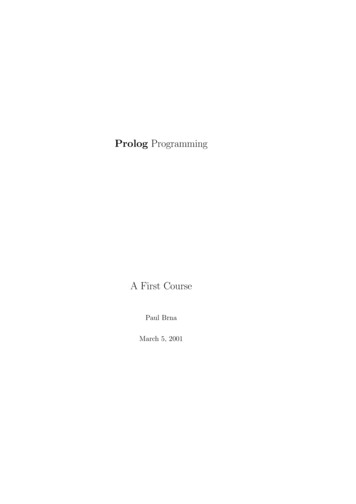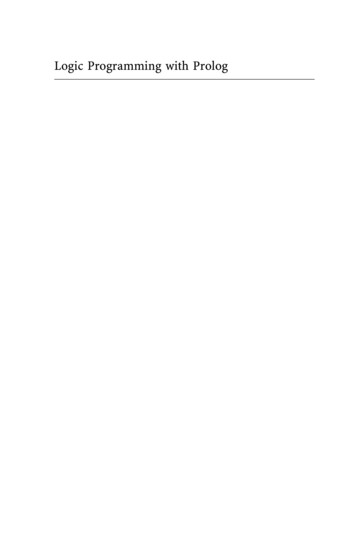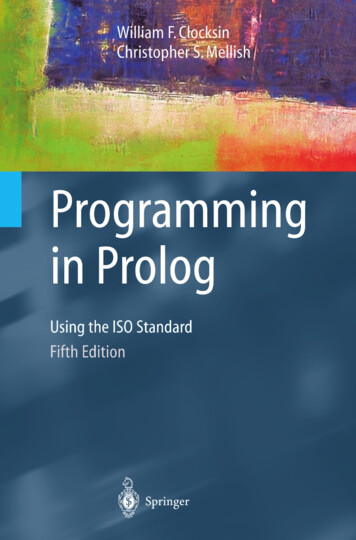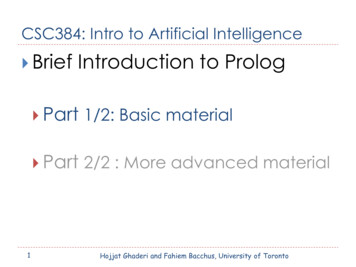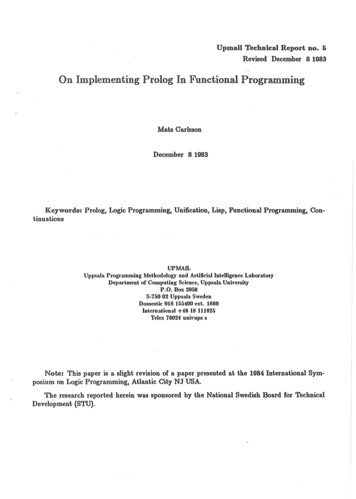
Transcription
UpmaU Technical Report no. 5Revised December 8 1983On Implementing Prolog In Functional ProgrammingMa.ts CarlssonDecember 8 1983Keywords: Prolog, Logic Programming, Unification, Lisp, Functional Programming, ContinuationsUPMAILUppsala Programming Methodology and Artificial Intelligence LaboratoryDepartment of Computing Science, Uppsala UniversityP.O. Box 2059S-750 02 Uppsala SwedenDomestic 018 155400 ext. 1860International 46 18 UHl25Telex 76024 univups sNote: This paper is a slight revision of a paper presented at the 1984 International Symposium on Logic Programming, Atlantic City NJ USAThe research reported herein was sponsored by the National Swedish Board for TechnicalDevelopment (STU).
Upma.il Technlea.l Report no. 5Revised December 8 1983On Implementing Prolog In Functional ProgrammingMats CarlssonDecember 8 1983Keywords: Prolog, Logie Programming, Unification, Lisp, Functional Programming, ContinuationsUPMAILUppsala Programming Methodology and Artificial Intelligence LaboratoryDepartment of Computing Science, Uppsala UniversityP.O. Box 2059S-750 02 Uppsala SwedenDomestic 018 155400 ext. 1860International 46 l8 111925Telex 70024 univups 11Note: This paper is a slight revision ora paper presented at the 1984 International Symposium on Logie Programming, Atlantic City NJ USAThe research reported herein was sponsored by the National Swedish Board for TechnicalDevelopment (STU).
M. CarlssonOn Implementing Prolog In Functional ProgrammingTable of Contents1. Abstract . . . . . . . . . . . . . . . . . . . . . . . . . . . . . . . . . . . . . . . . . . . . . . . . . . . . . . . . . . . . 22. Achieving Backtracking . . . . . . . . . . . . . . . . . . . . . . . . . . . . . . . . . . . . . . . . . . . . . . . . . 22.1 Success Continuation Scheme . . . . . . . . . . . . . . . . . . . . . . . . . . . . . . . . . . . . . . . . . . . . 22.2 Proof Stream Scheme .22.3 Interpreters .22.4 Comparison . . . . . . . . . . . . . . . . . . . . . . . . . . . . . . . . . . . . . . . . . . . . . . . . . . . . . . . . . 5o o 3. Structure Sharing vs. Structure Copying . . . . . . . . . . . . . . . . . . . . . . . . . . . . . . . . . . . . 53.1 Structure Copying Interpreter .64. Adding Builtin Predicates . . . . . . . . . . . . . . . . . . . . . . . . . . . . . . . . . . . . . . . . . . . . . . . 75. Adding Cut .6. Prolog . . . . . . . . . . . . . . . . . . . . . . . . . . . . . . .7. Conclusions . . . . . . . . . . . . . . . . . . . . . . . . . . .8. Appendix I: Proof Streams With Continua.tiomt9. Appendix II: A Complete Interpreter . . . . . . . .10. References . . . . . . . . . . . . . . . . . . . . . . . . . . .1o. . . . . .Deeember . . 8. 9. 91010128 1083
On Implementing Prolog In Functional ProgrammingM. Carlsson1. AbstractThis report surveys techniques for implementing the programming language Prolog. It f ocuses on explaining the procedural semantics of the language in terms of functional programmingconstructs. The techniques success continuations and proof streams are introduced, and it isshown how Horn clause interpreters can be built upon them. Continuations are well knownfrom denotational semantics theory, in this paper it is shown that they are viable constructs inactual programs.Other issues include implementation of logical variables, structure sharing w. structurecopying, builtin predicates, and wt.2. Achieving BacktrackingSeveral authors 4 1 11 , 7 have proposed abstract machinery to implement the backtrackingbehavior of Prolog. Typically the abstract machine includes a set of registers and various stackscarrying the state of the machine. Backtracking amounts to restoring parts of this state u itwas at some previous time.In this section, we will give a more abstract implementation of backtracking using conceptsfrom functional programming. Continuations II are the workhorse for achieving the desiredcontrol structure. Recursion is used instead of manipulation of explicit sb.cb, and parameterpassing is used instead of assignments to machine registers.There are at least two fundamentally different techniques for achieving backtracking and wewill call them proof streams and success continuations. In this paper, the word "continuation"denotes any function that is either passed as an argument or returned as a value.2.1 SucceBS ContinuationSchemeThe idea here is that the theorem prover receives an extra argument, the sut:cess continuation. If the theorem prover succeeds in proving its goal, it calls this continuation. If it fails, itsimply returns. Backtracking is achieved by the possibility that the theorem prover finds severalproofs of its goal, in which case it calls the continuation for each proof found.2.2 Proof StreamSchemeHere, the theorem prover returns a proof stream, which conceptually is a lazily evaluatedlist of environments, corresponding to the possible proofs of the given query. In a concrete ·implementation, a proof stream could be either()for failure i.e. no more proofs, or a pair(environment . continuation)for success i.e. a proof was found. Continuation is a function that returns a new proof stream.Environment could be the set of variable substitutions involved in a particular proof. Backtracking is achieved by calling the continuation of successive proof streams until failure eventually2December 8 1083
On Implementing Prolog In Functional Programmingresults. To our knowledge this idea was first conceived by AbelsonKornfeld 6 1 M. CarlssonIt has been used later by2.3 InterpretersWe present here running implementations of the two techniques written in pure Lisp.A continuation is implemented as a Lisp function consed to an incomplete argument list.The continuation is called with additional arguments that complete the argument list, which isthen passed to the Lisp function.Prolog data.types used are atoms, pairs, and variables. Variables are implemented as symbolsthat begin with a "7".Variable bindings are kept in an association list consisting of pairs((variable . indezl) . (term . indez2))where the indexes are used to distinguish between synonymous variables belonging to differentuses of the same assertion. The index is increased once per resolution step. This is essentiallythe structure ,haring technique of Boyer and Moore 2 It is discussed in more detail in chapter3.The database is only indexed on predicate symbols. The :astJertion,property of a symbolcontains a list of assertions.Success ContinuationInterpreterThis is a MacLisp implementation of the above ideas. It defines a Horn clause interpreterand includes predicates about appended and reversed lists.(defun prove (env j goals i cont);;Proves wgoals seen through index wi" and calls;; wcont". . wJ" is next available indez.(cond ((null env) nil);;An impossible environment is empty.((null goals) (invoke cont env j))(t (resolve (car goals) i (assertions (car goals)) j '(prove ,(cdr goals) ,i ,cont) env))))(defun resolve (goal i assertions j cont env);;For each proof of "goal" with respect to «assertions",;; "cont is called.(cond ((null assertions) nil)((prove (unify goal i (caar assertions) j env) (1 j) (cdar assertions) j cont.))(t (resolve goal i (cdr assertions) j cont env))))(defun unify (x i y j e);;Returns a non-empty environment upon success.(unifyl (ult (cons x i) e) (ult (cons y j) e) e))3December8 1083
On Implementing Prolog In Functional ProgrammingM. Carlsson(defun unifyl (xi yj e)(cond ((null e) e)((and (eq (car xi) (car yj)) (eq (cdr xij (cdr yj)))e)((and (consp (car xi)) (consp (car yj)))(unify (cdar xi) {cdr xi) (cdar yj) (cdr yj)(unify (caar xi) (cdr xi) (caar yj) (cdr yj)e)))((variable-symbol-p(car xi)) (cons (cons xi yj) e))((variable-symbol-p(car yj)) (cons (cons yj xi) e))((equal (car xij (car yj)) e))){defun ult (x e);;Follows chain of linked variables.{let ((pair (assoc x e)))(cond ((null pair) x)((eq x (cdr pair)) x)(t (ult (cdr pair) e)))))A predicate to append two lists could for example be represented as(defprop append(((append (?X. ?XS)?Y (?X. ?ZS)) (append ?XS?Y ?ZS))((append O?X ?X))):assertions)Auxiliary functions include invokefor invoking continuations, variable-symbol-pfor recognizing variables, assertions for retrieving appropriate assertions from the database, and a toplevelfunction.Proof StreamInterpreterTo arrive at an interpreter based on proof streams, the functions prove and resolve aboveshould take proof streams instead of continuations as arguments, and should return proofstreams as values.The following code implements streams as ordinary lists. Under lazy evaluation this wouldresult in the desired backtracking. The environment in the above discussion of proof streams isactually implemented as a pair of (i) the variable binding a.list and (ii) next available index.(defun prove (stream goals i);;Each goal "filters11 the proof stream.(cond ((null stream) 0)((null goals) stream)(t (prove (resolve stream (car goals) i (assertions (car goals)))(cdr goals)·i))))4December8 1083
On Implementing Prolog In Functional ProgrammingM. Carlsson(defun unify1 (xi yj e)(cond ((null e) e)((and (eq (car xi) (car yj)) (eq (cdr xQ(cdr yj)))e)((and (consp (car xi)) (consp (car yj)))(unify (cdar xi) (cdr xi) (cdar yj) (cdr yj)(unify (caar xi) (cdr xi) (caar yj) (cdr yj)e)))((variable-symbol-p(car xi)) (cons (cons xi yj) e))((variable-symbol-p(car yj)) (cons (cons yj xi) e))((equal (car xij (car yj)) e)))(defun ult (x e);;Follows chain of linked variables.(let ((pair (assoc x e)))(cond ((null pair) x)((eq x (cdr pair)) x)(t (ult (cdr pair) e)))))A predicate to append two lists could for example be represented as(defprop append(((append (?X . ?XS)?Y(?X . ?ZS)) (append ?XS?Y?ZS))((append O?X ?X))):assertions)Auxiliary functions include invokefor invoking continuations, variable-symbol-pfor recognizing variables, assertions for retrieving appropriate assertions from the database, and a toplevelfunction.Proof StreamInterpreterTo arrive at an interpreter based on proof streams, the functions prove and resolve aboveshould take proof streams instead or continuations as arguments, and should return proofstreams as values.The following code implements streams as ordinary lists. Under lazy evaluation this wouldresult in the desired backtracking. The environment in the above discussion or proof streams isactually implemented as a pair of (i) the variable binding a.list and (ii) next available index.(defun prove (stream goals i);;Each goal afilters the proof stream.(cond ((nullstream) 0)((null goals) stream)(ti (prove (resolve stream (car goals) i (assertions (car goals)))(cdr goals)·i))))4December8 1083
On Implementing Prolog In Functional ProgrammingM. Carlsson(defun resolve (stream goal i assertions);;Each stream element is replaced b,; a new .stream;; incorporating the proofs of «goaP.(cond ((nullstream) 0)(t (append (resolvel goal i assertions (cdar stream) (caar str am))(resolve (cdr stream) goal i assertions)))))(defun resolve! (goal i assertions j env)(cond ((nullassertions) 0)((null env) 0)(t (let ((envl (unify goal i (caar assertions) j env)))(append (prove «(tenvl . ,(1 j))) (cdar 1ssertions) j)(resolvd goal i (cdr assertions) j env))))))A concrete implementation along the lines in Section 2.2 is given in Appendix I.2.4 ComparisonIt is fairly obvious that using success continuations recurses deeper and so consumes morestack space, whereas using proof streams constructs more delayed objects and so consumesmore cons space. However, by introducing in the code special cases for e.g. last conjunct or lastdisjunct, the behavior of both schemes improves significantly.Moreover both interpreters contain · plenty or direct and indirect tail recursion, which ofcourse is transformed to iterative form in "production" versions of the algorithms.3. Structure Sharing vs. Structure CopyingA major source of inefficiency in the above interpreters is the implementation of the bindingenvironment. It is implemented as an association list without any indexing. To get the boundvalue of a variable one may have to search the whole list. Worse, one may have to do repeatedsearches in case there are variable-to-variable bindings. This means that execution times becomeat least O(n 2 ), where n is the number of nodes of the and-tree of a proof.In structure sharing implementations such as Warren's11every use of an assertion has its ownactivation-record like binding environment. There is then no need to search the environmentfor a binding. Warren lets a base register point to the activation record and assigns offsets tovariables. He is then able to get a variable binding in just one machine instruction. Structuresharing is typically implemented to let unify destructively update the binding environments.Another method is structure copying in which one uses copies of assertions. A new copyis constructed in each resolution step. The copies contain value cells, and unify is allowed todestructively update these. Whether it is worth while to recycle the copies is an open question.A more sophisticated variant is unification driven structure copying, where "pure code" iscopied only when it is unified with a variable. This variant is used in ·the systems described byMellish 8 and by Carlsson and Kahn 11 5December 8 1083
On Implementing Prolog In Functional ProgrammingM. CarlssonWith destructive changes, the need to undo these arises. Structure sharing and structurecopying implementations typically use a reset list or trail to record all variable bindings, in orderto know what to undo upon backtracking.The cost of constructing copies of assertions should be weight d against the relative complexity of structure sharing implementations where terms always 1hiust be "seen" through anindex (a pointer to a binding environment). This means that twice as many arguments have tobe passed around in the inner loop of the interpreter.On computers with indirect addressing support in Lisp one can even make pointers to valuecells totally transparent. This is a very attractive feature since it drastically reduces the costof interfacing Prolog to Lisp, which one typically wants in a Lisp-based Prolog system. Anextensive comparison of structure sharing vs. structure copying has been done by Mellish 11 We will now further refine the success continuation technique to use structure copying. Itis left as an exercise to the reader to implement indexed structure sharing.3.1 StructureCopying InterpreterValue cells are represented here as pairs(h111r .value)The value field of an unbound value cell points to the cell itself.The following is the central parts of a success continuation interpreter that uses "naive"structure copying. Note here that an assertion is represented as code to construct a copy of theassertion in question.(defun prove (go111lscont);;Proves «goala16 and calla «cont16 (cond (goals (resolve (car goals) '(prove ,(cdr goals) ,cont)))(t (invokecont))))(defun resolve (goal cont);;For all proofa of «goal", «cont11 is called.(try-Hsertions goal (assertions go111I) trail"' cont))(defun try-111ssertions(goal assertions mark cont)(cond (assertions(cond ((try-assertion goal (car assertions) cont))(t (reset mark);;Reset trail back to marlt:11 (try-111ssertionsgoal (cdr assertions) mark cont))))))(defun try-assertion (goal 111ssertioncont)(cond ((unify go111I(funcall (car assertion)))(prove (fum::aU(cdr assertion)) cont))))6December8 1083
On Implementing Prolog In Functional ProgrammingM. Carlsson(defun unify (x y)(cond ((eq x y))((and (consp x) (consp y))(and (unify (dereference (car x)) (dereference (car y)))(unify (dereference (cdr x)) (dereference (cdr y)))))((variable-px) (unify-variablex y))·((variable-py) (unify-variabley x))((equal x y))))(defun unify-variable(x y);;Unifies a variable with a term.(progn (push x trail*) (rplacd x y)))(defun dereference (x);;Follows chain of linked variables.(cond ((variable-px)(cond ((eq x (cdr x)) x)(t (dereference (cdr x)))))(t x)))The global variable trail* holds the reset stack. The function cell creates a value cell. Thefunction reset restores value cells to the unbound state. Variable-pis a predicate for recognizingvalue cells.Each assertion in the database is represented by a pair of functions, where the first element constructs the head of an assertion and the second element const:ruc:b the body. This isexemplified by the database entry for append:'(defprop append((app-1-1 . app-1-2) (app-2-1 . app-2-2)):assertions)(defun app-1-1 0(setq ?X (cell)) '(append O,?X ,?X))(defun app-1-2 0 10)(defun app-2-1 0(setq ?X (cell) ?XS (celQ?Y (cell) ?ZS (cell))'(append (,?X . 0?XS) ,?Y (,?X . ,?ZS)))(defun app-2-2 0 «((append,?XS ,?Y ,?ZS)))A Note on DeterminacyIt should be noted that the stack space consumption of the above interpreter can be muchreduced if prove can test whether a goal is determinate, viz.(defun prove (goals cont)(cond ((nullgoals) (invoke·cont))((determinate (car goals))(and (resolve (car goals) '(true)) (prove (cdr goals) cont)))'(t (resolve (car goals) '(prove ,(c:drgoals) ,cont)))))7December8 1083
On Implementing Prolog In Function l ProgrammingM. Carlsson4. Adding Builtin PredicatesIn addition to the pure Horn clause theorem proving capabilities, any Prolog implementationneeds builtin predicates. This can be done e.g. in the following way: Let the :assertions propertyof the predicate symbol be the pair(:builtin . function)where function accepts two arguments: a goal and a continuation, Resolve needs to take care ofthis case. AB an example, we show here how to implement bagof with this technique.(defun resolve (goal cont)(let ((assertions (assertions goal)))(cond ((eq ':builtin (car assertions))(fum::all(cdr assertions) goal cont))(t (try-assertions goal assertions *trail* cont)))));;(bagof ?t ?p ?b}: ?b is the bag of all ft such that Pp holds(defprop bagof (:builtin . bagof-prover) :assertions)(defun bagof-prover (goal cont)(let ((mark *trail*)(reslist (list Q)) ((?t ?p 7b) (cdr goal)));;Reslist collects the result.(resolve ?p '(bagof-aux ,?t ,reslist))(reset mark)(cond ((unify (dereference ?b)(nreverse (car reslist)))(invoke cont)))))(defun bagof-aux (term reslist)(push (instantiate (dereference term)) (car reslist))nil)where instantiate is a function that copies its argument, removing bound value cells and replacingunbound value cells by fresh ones. This is necessary since different proofs of fp may assigndifferent values to value cells in ?t.Note that bagof-aux always returns nil. This is to force the theorem prover to really findall proofs of 7p. In try-assertions, the value returned from the non-tail-recursive call to prove istested, and if non-nil, no more assertions are tried. This is used by the toplevel function proveso that the user can stop the search at a particular proof. It also prepares for the issue comingup in the next section.5. Adding CutThe cut control primitive needs extra machinery. The test in try-assertions mentionedabove offers the control alternatives "find all proofs" vs. "find first proof" for a given goal.Cut, however, is more complex because it is lexically scoped, and so at run time one needssome device that can mimic lexical scoping. One such device is to keep track of the ancestordepth of the current and-tree node. Instead of returning nil for failure, the theorem prover and8Deeember8 1083
On Implementing Prolog In Functional ProgrammingM. Carlssonbuiltin functions can return an integer specifying an ancestor depth to return. to. These ideasare implemented as follows.(defun prove (goals contd)111;;Proves /ligoalsat depth d111 and calls cont111 (cond (goals (resolve (car goals) (prove ,(cdr goals) ,cont ,d) d))(t (invoke cont))))(defun resolve (goal cont d)(let ((assertions (assertions goal)))(cond ((eq ':buiitin' (car assertions))(fum:all (cdr assertions) goal cont d))(t (try-assertions goal assertions trail"' cont d)))))(defun try-assertions (goal assertions mark cont d)(cond (assertions(let ((msg (try-assertion goal (cir assertions) contd)));;This code returns «msg111to the right level.(cond (( msg d)(reset mark)(try-assertions goal (cdr assertions) mark contd))(( msg d) "'failure"')(t msg))))(t *failure"')))(defun try-assertion (goal assertion cont d)(cond ((unify(fum::all(car assertion)));;The depth is increased in each resolution step.(prove (funcall (cdr assertion)) cont (1 d)))(t *failure*)))(defprop cut (:builtin . cut-prover) :assertions)(defun cut-prover (ignore contd);;Upon backtracking, cut fails the parent goal.(invoke cont) (1- d))The constant *failure contains a large integer.6. PrologTo extend the toy interpreters of this paper into full-fledged Prolog systems is straightforward and has been done. The resulting system is comparable in speed with interpretedDECsystem-10 Prolog and is listed in Appendix II.7. ConclusionsWe have surveyed techniques for implementing Prolog interpreters in Lisp. We have accounted for the procedural semantics of the language in terms of functional programming constructs which can be considered a very high level abstract machine.9December8 1083
On Implementing Prolog In Functional ProgrammingM. CarlssonRelated work includes Komorowski 6 He gives a denotational semantics for Prolog involving configurations and stacks to hold the state of his abstract machine. He made no use ofcontinuations. This is surprising considering how well they suggest themselves for defining theoperational semantics of Prolog as we have tried to show in this paper.8. Appenqix I: Proof Streams With ContinuationsIThe following is the central part of a proof stream interpreter2.2. All of these functions return proof streams which are eithera:swu discussed in section()for failure i.e. no more proofs, or a pair(environment . continuation)for success i.e. a proof was found. Continuation is a function that returns a new proof stream.Environment is a pair of (i) the variable substitutions involved in a particular proof and (ii) nextavailable index. Backtracking is achieved by calling the continuation of successive proof streamsuntil failure eventually results. All of these functions return proof streams.(defun prove (env newi goals oldi)119;;Returns the proofs of "goal15in "ent1119 (cond ((null env) 0)((nullgoals) '((,env . ,newi) . (false)))(t (invoke-in-each(resolve (car goals) oldi (assertions (car goals)) newi env)'(prove ,(cdr goals) ,oldi)))))(defun resolve (goal oldi assertions newi env);;Returns the proofs of "goal" in "envw.(cond ((null assertions) 0)(t (invoke-after(prove (unify goal oldi (caar assertions) newi env)(1 newi)(cdar assertions)newi)"(resolve ,goal ,oldi ,(cdr assertions) ,newi ,env)))))(defun invoke-after (streaml cont);;Appends «cont" onto the stream "tJtream1119 (cond ((null streaml) (invoke cont))(t (cons (car streaml) "(invoke-after* ,(cdr streaml) ,cont)))))(defun invoke-in-each (streaml cont);;Invokes "cont119 in each element of a proof dream(cond ((null streaml) 0)(t (invoke-after (invoke cont (c1111rstreaml) (cdar streaml))'(invoke-in-each* ,(cdr streaml) ,cont)))))10Deeember8 1083
On Implementing Prolog I.n Functional ProgrammingM. Carlsson(defun invoke-after*(delayed continuation)(invoke-after (invokedelayed) continuation))(defun invoke-in-each*(delayed continuation)(invoke-in-each(invokedelayed) continuation))9. Appendix II: A Complete InterpreterWe give here the source listing of a complete structure copying Prolog interpreter.11December8 1983
-*- Mode: Lisp; Base: 10.; -*A structure copying Prolog written In MacLlep. 1200-1500 LIPS unleseWritten by Mata Carlsson, UPMAIL,Uppsala University,1983.;Thie ie an Interpreter;It'sfor "naked" Prolog,It has very few bulltlnGC.predicates.free to use by anyone but If you make money out of It I would llke eome.;A lot of direct and indirect tail recursion to be transformed;by someone who has a good source to source optimizer.;Syntax:to IterationTerms and predicationsare lists ( functor . arguments ),assertionsare lists ( consequent . antecedents ),variables are symbols beginning with"?".:;Toplevel functions:;(yaq): (define name . assertions )Read-prove-printtop loop.Defines predicates,;;Bui I tin predicates:; (cut); (cal I ?goal); (bagof ?t ?goal ?b); (lisp-predicate?form); (lisp-command ?form);(lisp-value?var ?form);(cl ?clause); Caddel ?clause); (addcl ?clause ?n)Infamous control primitive.Tries to prove ?goal,?B la a bag of instances of ?T that satisfy ?goal,?Form is lisp-evaluatedand must return non-NIL.?Form is lisp-evaluated,may return whatever,?Var le the lisp-value of ?form,?Clause la an assertion in the knowledge base, Backtracks.?Clause le added to the knowledge base.?Clause is added after the ?n-th clause of lteprocedure.Clauses matching ?clause are deleted. Backtracke.Deletes ?n-th clause of ?predicate.;; (delcl; (delcl?clause)?predicate?n)(declare (flxsw t) (special(defvar l!Ctrai'* ())(defvar *inferences* 0)(defvar sfallure* 32767)(defmacro cellO'(let((x (cone lvarl nl I)))(rplacdw w)))(def macro conap he) (not (atom , w)))(defmacro variable-p(w) '(and(defmacro unify-variable(defmacro aaaertione(w y)(goal)(conep , ) (eq 'lvarl'(progn'(get(push ,w 111trail111)(rplacd(car ,goal)'(funcal I (car ,aeeertion)))(defmacro body (assertion)'(funcal I (cdr ,a!!Bertlon)))(car, ),w,y)))'1aea0rtions))(defmacro head (assertion)(defmacro Invoke (x) '(apply(car ,w))))(cdr ,w)))(defmacro defbul ltln (name &rest body)(let ((g (genaym)))'(progn 'compl le(defun ,g (goal continuation depth) ,ebody)(defprop ,name C:builtin.,g) :assertions))))ldefun instantiate(x generator);;create a copy of where unbound variables(I et (*ce II sill) Clna tant I a te-1 w generator)))are handled by generator(defun lnetantiate-1(x generator)(cond ((variable-px)Ccond ( (aseq w l!Cce11a ) (cdr (aeeq l!Cce110111)))(t (let((c (funcall generator w)))(push (cons c) l!Ccelle*) c))))( (conep ,d (cone (Instant i ate-1 (dereference Ccar w)) generator)(lnetantiate-1(dereference (cdr w)) generator)))(tx)))(defun copycell (Ignore);;this generator just makes a new value cellCceII l l(de fun ?ce 11 ( i gnorel.11this generator creates a symbol ?0 ?1 (maknam '(#/? ,( #/0 (length 111cells111)))))11--------------------- ---KERNELOF INTERPRETER--------------------------11
(head-name (gensym))(body-name (gensym)))(push (cons head-name body-name) toplist)'((defun ,head-name (), o (mapcar ( I ambda(v) (11etq , v ce 11))) headvars),headcode)(defun ,body-name (), !mapcar '(lambda(v) '(setq ,v (cell)))(diffq bodyvars headvars)),bodycode))))aseertione)(defprop ,name ,(nreversetoplist)sassertlons))))(defun yaq 0(do ( (mark 111trai I111))( 0)(format t "N%YA0 ")(let* ((sexpr (read))((eexprvars sexprcode) (variables-and-constructoreexpr))(eel IsCmapcar '(lambda(x) (set x (cell)))eexprvars)))(gc)(unwind-protect(prove'(, (eval eexprcode)(liep-predicate-?vare(display ',eexprvare',eel le ',ll!inferences* ',(runtime)))) ( ) 0)(reset mark)))))(defmacro gprinl(x) '(funcall(or prinl'prinl),w))(defun display (names eel le Inf time)(let ((dt (- (runtime) time)))(format t ",-,%Jt took .,s microseconds, .,s LIPS." dt(//(II! 1000000, (- ll!inferenceell! inf))dt))(mapc #'(lambda (n c) (format t ",,,%--S. "n) (gprinl(progn (format t ",-,%Ok?") (y-or-n-p))))c)) namH calls)(setatue linmode nil)(eetq base 10. ibase 10. !l(nopoint t)(a 11oc ' (Ii et (65536. 131072. 0. 25)) S---------------------------11(define lisp-command((lisp-command ?X) (lisp-predicate(define lisp-value((I iep-value ?X ?YI (lisp-predicate(progn ?Xti)))(unify '?X ?Y))))(define cl( (c I ?c I) (I c I-de Ic I I ?c I n 11) II(define addc I( (addc I ?c I) (I addc 11 ?c I))(Caddel ?cl ?n) (laddcll ?cl ?n)));;after(define delcllldelcl ?cl) (lcl-delcl I ?cl tll((delcl ?pred ?n) (ldelcl-11 ?pred ?n)))nth, 1-lndexed;;deletenth, I-indexed
ll fai Iurell )))(t(defbui I tin ldelcl-11(letll !!name (dereference (cadr goal)))In (dereference (caddr goal)))(assertions(get name ':assertlone)))!putprop name (delq !nth !1- n) aeeertione)!invoke continuation)})aeeertlone) :aeeertlone)(defbui I tin laddcl I(letll !!clause !instantiate!dereference (cadr goal)) '?cell))In (dereference (caddr goal)))(name (caar clause))(eave (get name ':aeeertione)))!eval '(define ,name ,clause))(cond ( (and (numberp n) (nthcdr n eave))(let ((x (nthcdr n eave)))(rp I acd x (cons (car x) (cdr x)))(rplaca x (car (get name ':aeeertlone)))(putprop name eave ':aeeertlonel))(t (putprop name (nconc eave (get name ':aeeertlone))(invoke continuation)))'aaeeertlone)))(defbui I tin bagof(let ((mark ll trai Ill ) (resl iet (I let Oil ((?t ?p ?b) (cdr goal)))(resolve (dereference ?p) '(bagof-aux , ?t ,reel let) depth)(reset mark)(cond ((unify (dereference ?b) (nreverl!IC!I(car reo 11at)))(invoke continuation))(t itcfailureitc))))(defun bagof-aux (term reel let)(push (instantiate(dereferenceitcfai lureitcl(defbulltlncall(resolveterm) 'copucell)(dereference(def bu i It in cut (invoke cont Inuat I on)(defbul I tin lisp-predicate(cond ((eval (instantiate(t ll failurell )))!car resllet))(cadr goal))(1-continuationdepth))depth))lcadr goal) 'progl))(invoke continuation))(defbuiltlnI lsp-predicate-?vare(cond (!eval (instantiate(cadr goal) '?cell))(t itcfallurell l)l(Invoke RO& TOPLEVEL------------------------aa(eval-when (compile eval load)(defmacro syntactic-variable-p(x);;an ugllJ way of saying (eq '? (getchar x lll'(and (sumbolp ,x) (e #/? (leh (car (pnget ,x 7)) -29.))))(defun variables-and-constructor(x);;returnsvariables occurring in x and a form that MIii create(let* (( variables )(code (conetructor x)ll(liet (nreveree itcvariablesitc) code)))x(defun
Keywords: Prolog, Logic Programming, Unification, Lisp, Functional Programming, Con tinuations UPMAIL Uppsala Programming Methodology and Artificial Intelligence Laboratory Department of Computing Science, Uppsala University P.O. Box 2059 S-750 02 Uppsala Sweden Dom


